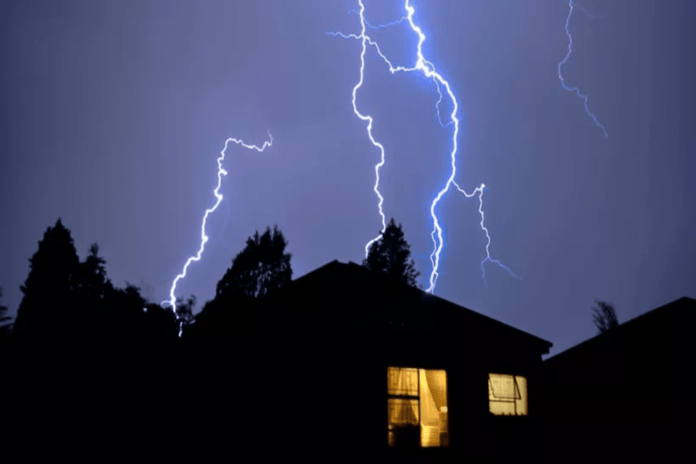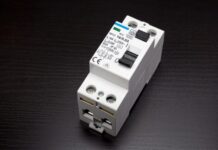Protect your home from the powerful forces of nature with lightning arrestors. Lightning strikes can be dangerous and cause significant damage.
Lightning is one of the most spectacular and powerful forces of nature, but it can also be dangerous. Every year, lightning strikes cause injury and death, as well as millions of dollars in damage to homes and businesses.
Lightning arrestors, also known as surge protectors, are designed to protect buildings and other structures from lightning strikes by diverting the electrical current away from the structure.
But, what is the meaning of lightning, and how do lightning arrestors work? In this post, we’ll explore the science behind lightning and how it can cause damage to buildings and other structures.
We’ll also take a closer look at lightning arrestors and how they can help protect your property from the damaging effects of lightning strikes.
An Overview: The Awe-Inspiring Power Of Lightning
Lightning is one of nature’s most breathtaking phenomena. It fills the sky with dazzling bolts of electricity, illuminating the darkness and capturing our imagination.
The sheer power and beauty of lightning strikes have fascinated humans for centuries, sparking countless myths, legends, and artistic interpretations.
But beyond its visual spectacle, lightning is an incredible force of nature, capable of unleashing immense energy in an instant. Each bolt can carry up to a billion volts of electricity and reach temperatures hotter than the surface of the sun.
The crackling sound that accompanies a lightning strike echoes through the air, a reminder of the raw power contained within each bolt.
Yet, with this awe-inspiring power comes great danger. Lightning strikes can cause devastating damage to buildings, infrastructure, and even human life.
The need to protect ourselves and our surroundings from the destructive force of lightning has led to the development of lightning arrestors.
In this blog post, we will explore the meaning and significance of lightning, delving into its characteristics, formation, and the science behind it.
We will also delve into the purpose and functioning of lightning arrestors, which play a crucial role in safeguarding against the potentially catastrophic consequences of a lightning strike.
Join us as we unravel the mysteries of lightning and delve into the world of lightning arrestors, equipping you with the knowledge to better understand and protect against this awe-inspiring force of nature.
Understanding Lightning: The Science Behind It
Understanding lightning is crucial to comprehending the importance of lightning arrestors. Lightning, a natural electrostatic discharge, is a fascinating phenomenon that occurs during thunderstorms.
It is a powerful force of nature that captivates us with its awe-inspiring displays of light and sound. At its core, lightning is the result of an electrical imbalance between the Earth’s surface and the atmosphere.
This imbalance is caused by the separation of positive and negative charges within a thundercloud. As the cloud moves and interacts with the surrounding air, these charges build up and create an intense electric field.
When the electrical potential difference becomes too great, it ionizes the air and creates a conductive path for the discharge to occur. This is what we see as a lightning bolt.
The discharge is a rapid flow of electrons from the negatively charged region to the positively charged region, or sometimes between different regions within the cloud itself.
The immense energy released during a lightning strike generates temperatures hotter than the surface of the sun, reaching up to 30,000 Kelvin (53,540 degrees Fahrenheit).
This extreme heat causes the surrounding air to rapidly expand, creating a shockwave that we hear as thunder.
Now that we have a basic understanding of the science behind lightning, we can appreciate the need for lightning arrestors.
These devices are designed to protect structures and electrical systems from the destructive power of lightning strikes.
Lightning discharge paths provide a low-resistance path, directing energy safely into the ground and reducing fire, damage, or electrical surge risks.
In the next section, we will delve deeper into the crucial role of lightning arrestors. We will also discuss how they work to safeguard our homes, businesses, and infrastructure.
Relax to uncover the secrets of effective lightning protection.
The Role Of Lightning Arrestors: Protecting Against Lightning Strikes
Lightning arrestors are essential tools for safeguarding against the powerful force of lightning.
These devices are designed to safeguard our homes, buildings, and electrical systems from the destructive effects of lightning strikes.
Lightning, a natural phenomenon that occurs during thunderstorms, is a discharge of atmospheric electricity.
It can generate extremely high voltages and currents, posing a significant threat to our electrical infrastructure.
Without proper protection, a lightning strike can cause devastating damage, leading to fires, equipment failure, and even the loss of life.
This is where lightning arrestors step in. Also known as surge protectors or lightning surge arrestors.
These devices are strategically installed to divert the high voltage surge caused by a lightning strike away from sensitive electrical equipment.
They act as a pathway for the lightning’s electrical current to safely reach the ground, bypassing critical systems and minimizing the risk of damage.
Lightning arrestors work on a simple principle – they provide a low-resistance path for the lightning surge to follow.
By offering a path of least resistance, they effectively redirect the massive electrical energy away from valuable assets and into the ground, where it can safely dissipate.
These devices are typically installed at key points in the electrical system, such as power lines, communication lines, and even on individual appliances and equipment.
They come in various types and designs, including rod-style arrestors, block-style arrestors, and gas discharge tubes, each tailored to specific applications and voltage levels.
While lightning arrestors play a critical role in protecting against lightning strikes, it’s important to note that they are not foolproof.
Lightning can be unpredictable, and its power can sometimes overcome even the best protective measures.
How Do Lightning Arrestors Work?
Lightning is a natural phenomenon that can be both awe-inspiring and dangerous. It is estimated that lightning strikes the Earth’s surface about 100 times every second, posing significant risks to both people and property.
To mitigate these risks, the invention of lightning arrestors has been a game-changer. So, how do lightning arrestors work?
These devices are designed to divert the massive electrical energy of a lightning strike away from vulnerable structures and into the ground.
Lightning arrestors consist of a metal rod or conductor that is strategically placed on top of buildings, towers, or other tall structures.
They serve as a path of least resistance for the lightning’s electric charge, preventing it from causing catastrophic damage.
The rod is typically made of copper or aluminum, as these metals are excellent conductors of electricity. When lightning approaches, the rod acts as a lightning attractor, providing a preferred path for the lightning bolt to follow.
Connected to the lightning rod is a network of conductive cables or wires that run down the structure and into the ground.
These cables are designed to safely transport the significant electrical current generated by lightning strikes, directing it into the earth.
The lightning arrestor safeguards against the destructive effects of a direct strike by diverting the lightning’s energy away from the structure.
Furthermore, contemporary lightning arrestors frequently have surge protection devices. These devices detect and redirect excess electrical energy away from sensitive equipment and electrical systems.
It is important to note that lightning arrestors do not prevent lightning strikes from occurring.
Instead, they provide a safer path for the electrical charge to follow, reducing structure damage. Furthermore, it reduces the chance of flames, explosions, or other catastrophic events as a result of a lightning strike.
Types Of Lightning Arrestors
Lightning arrestors are essential for safeguarding your property and electrical systems from the severe consequences of lightning strikes.
These powerful devices are designed to divert the immense electrical energy of a lightning strike away from your valuable assets, ensuring their safety and minimizing the risk of damage.
There are several types of lightning arrestors available on the market, each with its own unique features and capabilities.
Let’s dive into an overview of the most common types:
Rod or Franklin Lightning Arrestors
This is the most traditional and widely used type of lightning arrestor. It consists of a metal rod placed at the highest point of a structure, such as a building or a tower.
The rod is connected to a grounding system, providing a path for the lightning to follow. Franklin lightning arrestors are known for their simplicity, effectiveness, and cost-efficiency.
Surge Protective Devices (SPDs)
Also known as transient voltage surge suppressors, SPDs are advanced lightning arrestors that provide comprehensive protection against transient voltage surges.
They are typically installed at the main electrical panel of a building and are designed to regulate and limit the voltage spikes caused by lightning strikes or other electrical disturbances.
SPDs offer a higher level of protection and are essential for sensitive electronic equipment and systems.
Gas Discharge Tubes (GDTs)
GDTs are another type of lightning arrestor commonly used in telecommunications and data communication systems.
These devices utilize a sealed gas chamber that ionizes when a high-voltage surge occurs, creating a low-impedance path and diverting the energy away from sensitive equipment.
GDTs offer fast response times and can handle multiple surges without degradation.
Hybrid Lightning Arrestors
As the name suggests, hybrid lightning arrestors combine multiple technologies to provide enhanced protection.
These arrestors often incorporate features from both SPDs and GDTs, offering a comprehensive solution for safeguarding critical infrastructure and equipment.
Note:
Choosing the right type of lightning arrestor depends on various factors, including the nature of your property, the level of protection required, and the specific electrical systems in place.
It is advisable to consult with a professional electrician or lightning protection specialist to assess your needs and determine the most suitable lightning arrestor solution for your situation.
Remember, investing in high-quality lightning arrestors is not just about protecting your property; it’s also about safeguarding the lives of those inside and ensuring the uninterrupted functionality of important systems.
Installation And Placement Of Lightning Arrestors
Lightning arrestors are essential for safeguarding your property and electrical systems from the severe consequences of lightning strikes.
These devices are designed to safely divert the lightning’s energy into the ground, preventing it from causing damage to your electrical systems and appliances.
First and foremost, it is essential to consult with a qualified professional or an electrician who specializes in lightning protection systems. They will assess your property and determine the number and type of lightning arrestors needed.
The placement of lightning arrestors is strategic and requires careful consideration. Ideally, they should be installed at the highest points of your building, such as the roof or the top of a mast.
This ensures that they can intercept and capture lightning strikes before they reach critical areas. Additionally, it is important to consider the proximity of sensitive equipment and structures that need protection.
Lightning arrestors should be installed near these areas to provide a direct path for the lightning’s energy to dissipate harmlessly into the ground.
Furthermore, the grounding system plays a vital role in the effectiveness of lightning arrestors. Proper grounding ensures that the captured lightning energy is efficiently dispersed into the earth.
It is crucial to follow the recommended grounding guidelines and regulations to maximize the performance of the lightning protection system.
Regular inspections and maintenance of lightning arrestors are also essential. Over time, environmental factors, such as corrosion or physical damage, can compromise their effectiveness.
A professional should inspect and test the lightning protection system periodically to identify any issues and ensure its continued reliability.
Remember that investing in the necessary safety equipment and following the right guidelines will give you peace of mind during thunderstorms. It can also reduce your chances of getting struck by lightning.
Common Myths And Misconceptions About Lightning And Lightning Arrestors
There are several prevalent myths and misunderstandings about lightning and lightning arrestors that need to be dispelled.
The safety of your property and the effective operation of lightning protection devices depend on your knowing the reality behind these common misunderstandings.
One common myth is that lightning never strikes the same place twice. In reality, lightning can and does strike the same location multiple times.
Tall structures such as trees, buildings, and lightning rods are more likely to be struck, but lightning can also strike the ground or other objects in its path.
Another misconception is that lightning arrestors attract lightning. In fact, lightning arrestors do not attract lightning.
They are designed to provide a path of least resistance for the lightning to follow, diverting it away from sensitive equipment or structures.
By providing a better path for the lightning discharge, lightning arrestors help protect against damage caused by the high voltage and current associated with lightning strikes.
Some people believe that surge protectors alone are enough to protect against lightning strikes.
While surge protectors are important for safeguarding electrical equipment from voltage spikes, they are not designed to handle the extreme power of a lightning strike.
Lightning arrestors, on the other hand, are specifically designed to handle the high energy levels of a lightning strike and provide a direct path for the lightning to follow.
The idea that lightning can’t strike under a clear sky is another common myth. While it is true that most lightning occurs during thunderstorms, it is possible for lightning to strike even when the skies are clear.
These types of lightning strikes are known as “bolts from the blue” or “anvil lightning” and can occur when a thunderstorm is located far away, but still within striking distance.
It is important to educate yourself about the facts and dispel these myths to ensure proper understanding and implementation of lightning protection measures.
Consulting with a professional lightning protection specialist can help you navigate through the misconceptions and ensure the safety of your property and the people within it.
Importance Of Regular Maintenance And Inspection Of Lightning Arrestors
Regular maintenance and inspection of lightning arrestors are crucial.
These devices play a vital role in protecting your property and equipment from the destructive power of lightning strikes.
Over time, lightning arrestors can become worn or damaged due to various environmental factors. Such as exposure to extreme weather conditions or debris accumulation.
Regular inspections allow you to identify any signs of wear or damage, such as corrosion, loose connections, or physical deterioration.
By catching these issues early on, you can prevent potential failures and maintain the proper functioning of the lightning arrestors.
Maintenance procedures may include cleaning the arrestor to remove dirt, dust, or debris that can hinder its performance.
This is especially important for outdoor lightning arrestors that are exposed to elements like rain, wind, and pollution.
Additionally, it is essential to ensure that all connections are secure and tight, as loose connections can lead to poor grounding and reduced effectiveness.
Apart from physical inspections, it is also advisable to conduct periodic testing of lightning arrestors. This can be done using specialized equipment to measure parameters such as voltage protection level and discharge capability.
Testing helps verify that the arrestors are operating within their specified limits and provides assurance that they will perform as intended during a lightning event.
Routine maintenance and inspection, which guarantees the effective operation of lightning arrestors enhances an electrical system’s overall safety.
Lightning-related electrical surges, fires, and equipment damage can all be reduced by taking quick action to remedy any problems.
Remember, lightning arrestors are not a “fit it and forget it” solution. They require ongoing attention and care to provide reliable protection.
Schedule regular maintenance and inspection intervals to stay ahead of potential problems.
Lightning Safety Tips For Individuals And Property
Safety should always come first for both individuals and property owners when it comes to lightning.
Lightning strikes can be extremely dangerous – cause significant damage to buildings, and electrical systems, and even pose a threat to human life.
To ensure proper safety precaution, it is crucial to follow some important lightning safety tips.
- Seek shelter: When you hear thunder or see lightning, it is essential to seek shelter immediately. Move indoors to a sturdy building or a fully enclosed vehicle. Avoid seeking shelter under trees, open structures, or near bodies of water – these areas are more prone to lightning strikes.
- Stay indoors: Once you have found a safe shelter, it is important to stay indoors. Do this until the storm has passed and the threat of lightning has diminished. Avoid using electrical appliances or plumbing fixtures during a thunderstorm, as lightning can travel through these systems and cause harm.
- Unplug electronics: To protect your electronic devices from potential power surges, it is advisable to unplug them during a storm. This will help prevent damage to your devices and reduce the risk of fire hazards.
- Install lightning arrestors: Installing lightning arrestors might give your property an additional degree of security. In a case where you reside in a region where lightning storms are common. Lightning arrestors are devices designed to divert lightning strikes safely into the ground, preventing damage to structures and electrical systems.
- Stay away from windows and doors: During a thunderstorm, it is important to avoid standing near windows or doors. If lightning strikes nearby, it can shatter glass and cause injuries. Stay inside and away from these areas until the storm has passed.
- Educate yourself and others: It is important to educate yourself and those around you about lightning safety. Teach your family members, friends, and coworkers about the dangers of lightning. And also, the necessary precautions to take during a storm. This knowledge can help save lives and prevent injuries.
Final Thoughts: Lightning and Lightning Arrestors
In conclusion, using lightning arrestors can provide essential protection against the devastating effects of lightning strikes.
We may redirect lightning’s destructive fury and channel it toward protecting our important possessions by harnessing its strength.
Lightning, symbolizing power and destruction, can be transformed into a protective force through effective strategies and measures.
In this procedure, lightning arrestors are essential as protectors, deflecting lightning strikes away from equipment and structures.
Purchasing premium lightning arrestors with proper installation will lower the possibility of lightning strikes causing harm, injury, or even death.
Also, it gives lightning a path of least resistance. Hence, securely directing it into the earth with no harm to the surrounding environment.
Moreover, understanding the science behind lightning and its behavior can further enhance our ability to protect ourselves and our assets.
Lightning strike frequency and intensity can be utilized to make informed judgments about lightning arrestor design and placement.
Harnessing the power of lightning for protection requires a comprehensive approach that encompasses both knowledge and practical measures.
It is crucial to collaborate with experts in the field of lightning protection. This is to ensure the most effective solutions are implemented.
Finally, by accepting the usage of lightning arrestors, we may transform this formidable natural force into a potent ally.
Let us embrace the opportunity to safeguard lives, infrastructure, and valuable assets by harnessing the power of lightning for protection.
Remember that knowledge is power, and having this understanding will allow you to make sound choices about lightning protection. Stay safe, and may your days be free of storms!
Further Reading And References
The Electrical Grounding: Understanding the Electrical Connection to the Earth
Centers for Disease Control and Preventions: Lightning Safety Tips




